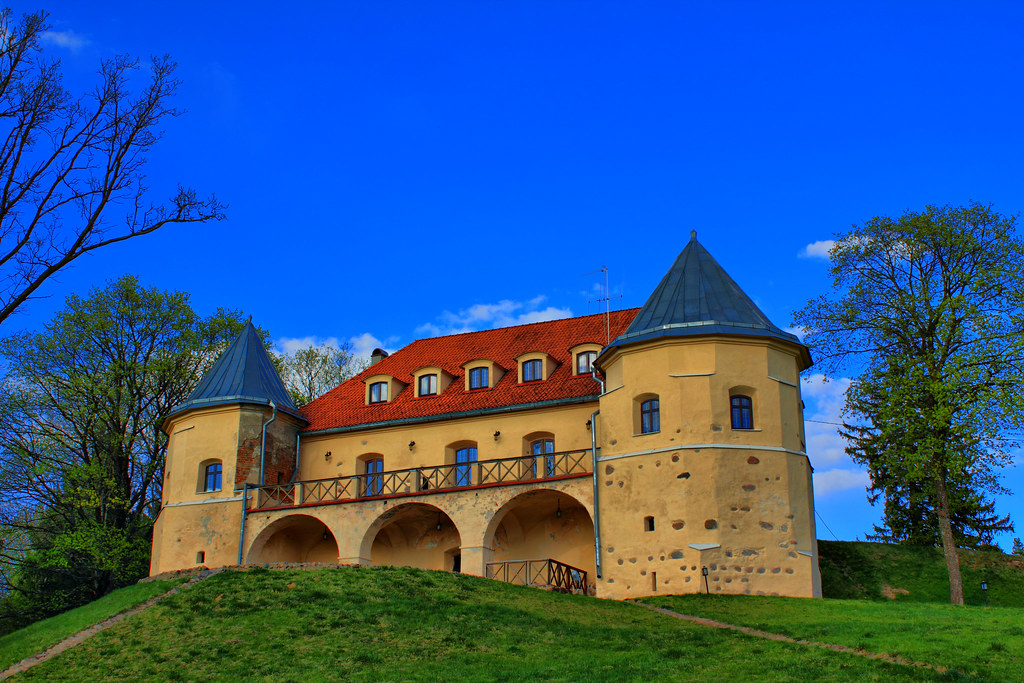Most beautiful castles in Lithuania
Most of Lithuania's early castles were wooden and have not survived. However, Lithuania is often called the "Land of Castles". During the medieval ages Lithuanians needed stone castles to defend their lands from different invaders from east (Russians) and west (Teutonic Order). Here is a list of most famous Lithuanian castles.

Gediminas' Tower
Gediminas' Tower is the only remaining part of the Upper Castle in Vilnius. The first fortifications were built of wood by Duke of the Grand Duchy of Lithuania, Gediminas. Later the first brick castle was completed in 1409 by Grand Duke Vytautas.
Read more about Gediminas' Tower
Trakai Island Castle
Trakai Island Castle on an island in Lake Galvė. The castle is sometimes referred to as 'Little Marienburg'. The construction of the stone castle was begun in the 14th century by Kęstutis, and around 1409 major works were completed by his son Vytautas the Great, who died in this castle in 1430.
Read more about Trakai Island Castle
Kaunas Castle
The precise construction date of the first Kaunas Castle is unknown. Archeological data suggests that a stone castle was built on the site during the middle of the 14th century. Situated on an elevated bank near the river junction it served as a strategic outpost and guarded nearby cities as well as trade routes.
Read more about Kaunas Castle
Trakai Peninsula Castle
Trakai Peninsula Castle is one of the castles in Trakai. Built around 1350–1377 by Kęstutis, Duke of Trakai, it was an important defensive structure protecting Trakai and Vilnius, capital of the Grand Duchy of Lithuania, against attacks of the Teutonic Knights.
Read more about Trakai Peninsula Castle
Raudone Castle
Raudonė Castle construction works started in late 16th century, during the reign of King Sigismund II August. A new renaissance castle was built on the ruins of the old one by a German knight, Hieronymus Krispin-Kirschenstein. The castle has since been rebuilt many times. The 18th century Polish owners of the Raudone estate, the family Olędzki (Olendzki) h.
Read more about Raudone Castle
Norviliskes Castle
Norviliškės Castle (a former monastery, also called Norviliškės Manor) is a Renaissance style castle. It was first mentioned in 1586. In 1617 the owners donated part of the real estate land to Franciscans. Around 1745 they built a monastery and a church in Renaissance style. The monastery was reconstructed at the end of the 18th century by Kazimieras Kaminskis.
Read more about Norviliskes Castle
Medininkai Castle
Medininkai Castle was built in the late 13th century or the first quarter of the 14th century. The defensive perimeter of the castle was 6.5 hectares; it is the largest enclosure type castle in Lithuania. The castle was built on plain ground and was designed for flank defence.
Read more about Medininkai Castle
Senieji Trakai Castle
The first enclosure-type brick castle in Senieji Trakai was built by Grand Duke Gediminas, who transferred the capital of Lithuania from Kernavė to Trakai (today\"s Senieji Trakai) before 1321.
Read more about Senieji Trakai Castle
Panemune Castle
The initial hillfort of the Teutonic Knights in Panemunė (erected 1343) was replaced by a present castle built in 1604-1610. It was built by Hungarian nobleman Eperjesh who bought the surrounding lands from Lithuanian local inhabitants. It is a typical 17th century feudal castle with a defensive tackle, living quarters and farm buildings.
Read more about Panemune Castle
Birzai Castle
Biržai Castle is an earth bastion-type castle. The construction started in 1586 by the order of Krzysztof Mikołaj Radziwiłł. In 1575, preparing for this construction, a dam was built on the Agluona and Apaščia rivers at their confluence, and the artificial Lake Širvėna, covering about 40 km², was created.
Read more about Birzai Castle